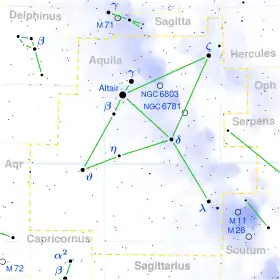23 Aquilae
23 Aquilae is a binary star[9] system in the equatorial constellation of Aquila. 23 Aquilae is its Flamsteed designation. It is at a distance of about 370 light-years (110 parsecs) with an apparent visual magnitude of 5.10,[2] which is bright enough to be faintly visible to the naked eye as an orange-hued star. The brightness of the star is diminished by 0.21 in magnitude because of extinction from interstellar dust and gas.[4] The system is moving closer to the Earth with a heliocentric radial velocity of –23 km/s.[4]
| Observation data Epoch J2000 Equinox J2000 | |
|---|---|
| Constellation | Aquila |
| Right ascension | 19h 18m 32.49608s[1] |
| Declination | +01° 05′ 06.4602″[1] |
| Apparent magnitude (V) | 5.10[2] |
| Characteristics | |
| Spectral type | K1 II/III[3] |
| U−B color index | +1.01[2] |
| B−V color index | +1.15[2] |
| Astrometry | |
| Radial velocity (Rv) | –23.13 ± 0.19[4] km/s |
| Proper motion (μ) | RA: +12.30[1] mas/yr Dec.: +17.47[1] mas/yr |
| Parallax (π) | 8.79 ± 0.51 mas |
| Distance | 370 ± 20 ly (114 ± 7 pc) |
| Absolute magnitude (MV) | +0.7[5] |
| Details | |
| Luminosity | 155[6] L☉ |
| Temperature | 4,660[6] K |
| Rotational velocity (v sin i) | 10[7] km/s |
| Other designations | |
| Database references | |
| SIMBAD | data |
The primary component of this system is a magnitude 5.31 K-type giant star or bright giant with a stellar classification of K1.[10] The star is radiating 155 times the luminosity of the Sun from its enlarged photosphere at an effective temperature of 4,660 K.[6] Orbiting at an angular separation of 3.25 arcseconds is a magnitude 8.76 companion star.[9]
References
- van Leeuwen, F. (November 2007), "Validation of the new Hipparcos reduction", Astronomy and Astrophysics, 474 (2): 653–664, arXiv:0708.1752, Bibcode:2007A&A...474..653V, doi:10.1051/0004-6361:20078357.
- Nicolet, B. (1978), "Photoelectric photometric Catalogue of homogeneous measurements in the UBV System", Astronomy and Astrophysics Supplement Series, 34: 1–49, Bibcode:1978A&AS...34....1N.
- Houk, N.; Swift, C. (1999). "Michigan catalogue of two-dimensional spectral types for the HD Stars, Vol. 5". Michigan Spectral Survey. 05: 0. Bibcode:1999MSS...C05....0H.
- Famaey, B.; et al. (January 2005), "Local kinematics of K and M giants from CORAVEL/Hipparcos/Tycho-2 data. Revisiting the concept of superclusters", Astronomy and Astrophysics, 430 (1): 165–186, arXiv:astro-ph/0409579, Bibcode:2005A&A...430..165F, doi:10.1051/0004-6361:20041272.
- Wilson, O. C. (1976). "Absolute magnitudes of stars from widths of chromospheric Ca II emission lines". Astrophysical Journal. 205: 823. Bibcode:1976ApJ...205..823W. doi:10.1086/154338.
- McDonald, I.; Zijlstra, A. A.; Boyer, M. L. (2012). "Fundamental parameters and infrared excesses of Hipparcos stars". Monthly Notices of the Royal Astronomical Society. 427: 343. arXiv:1208.2037. Bibcode:2012MNRAS.427..343M. doi:10.1111/j.1365-2966.2012.21873.x.
- Bernacca, P. L.; Perinotto, M. (1970), "A catalogue of stellar rotational velocities", Contributi Osservatorio Astronomico di Padova in Asiago, 239 (1), Bibcode:1970CoAsi.239....1B.
- "* 23 Aql". SIMBAD. Centre de données astronomiques de Strasbourg. Retrieved 2012-07-25.
- Eggleton, P. P.; Tokovinin, A. A. (September 2008), "A catalogue of multiplicity among bright stellar systems", Monthly Notices of the Royal Astronomical Society, 389 (2): 869–879, arXiv:0806.2878, Bibcode:2008MNRAS.389..869E, doi:10.1111/j.1365-2966.2008.13596.x.
- Eggen, O. J. (1962), "Space-velocity vectors for 3483 stars with proper motion and radial velocity", Royal Observatory Bulletin, 51, Bibcode:1962RGOB...51...79E.
